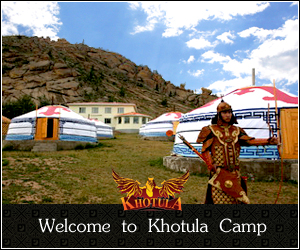Ger – Traditional Mongolian accomodation
 A round wooden-framed felt tent covered in durable while canvas seems to be the most simple description of this portable home, familiar to many from Russian word yurt. The modern shape of the Mongolian ger has been formed as the result of a long development from huts, marquees and wheeled abodes. The Mongolian ger has a 2500-3000 year history. Mongol nomads invented this type of dwelling the frame of which is chiefly made of willows and it’s covered with felt. This is a multipurpose dwelling which can be easily collapsed, transported to another place and put up again fully preserving its original shape. In medieval era large gers that belong to kings and nomadic chieftains were on special wheeled floors and were dragged by a number of oxen. The Mongolian ger has two key components, the wooden wall shell is called khana, the upper wooden poles (uni) usually measure 1.5-3 meters, the central supporting two columns are known as bagana and the uppermost smoke hole is toono.
A round wooden-framed felt tent covered in durable while canvas seems to be the most simple description of this portable home, familiar to many from Russian word yurt. The modern shape of the Mongolian ger has been formed as the result of a long development from huts, marquees and wheeled abodes. The Mongolian ger has a 2500-3000 year history. Mongol nomads invented this type of dwelling the frame of which is chiefly made of willows and it’s covered with felt. This is a multipurpose dwelling which can be easily collapsed, transported to another place and put up again fully preserving its original shape. In medieval era large gers that belong to kings and nomadic chieftains were on special wheeled floors and were dragged by a number of oxen. The Mongolian ger has two key components, the wooden wall shell is called khana, the upper wooden poles (uni) usually measure 1.5-3 meters, the central supporting two columns are known as bagana and the uppermost smoke hole is toono. A ger usually consists of 4-12 walls, depending on its size. The number of uni or upper poles ranges between 45-120 depending on the number of walls. All gers have a toono, smoke hole, and baganas( 2 columns) which support the toono. There are several felt layers covering the wooden framework and an outer white canvas which is designed to make the ger look prettier and protect the felt covers from rain and snow. Mongolian nomads, who move several times each year, pack their gers onto the back of camels and ox carts. It only takes half an hour to collapse an average ger and a bit longer to rebuild it.
A ger usually consists of 4-12 walls, depending on its size. The number of uni or upper poles ranges between 45-120 depending on the number of walls. All gers have a toono, smoke hole, and baganas( 2 columns) which support the toono. There are several felt layers covering the wooden framework and an outer white canvas which is designed to make the ger look prettier and protect the felt covers from rain and snow. Mongolian nomads, who move several times each year, pack their gers onto the back of camels and ox carts. It only takes half an hour to collapse an average ger and a bit longer to rebuild it.
 The door is always on the southern side facing the sunrise, providing more light inside the home. This is also designed not to let the northern wind into the ger through its door. However, Mongolians build their gers with the doors facing south as it has become a long-rooted tradition, whether the wind is usually from the north or south. While modern and western style houses are being built in Ulaanbaatar and other cities, rural Mongolians have retained their traditional lifestyle of which the ger is an integral part. As a visitor, you have a chance to stay in this unique dwelling at one of the ger camps in the countryside or experience living ways of Mongolian nomads by visiting their homes.
The door is always on the southern side facing the sunrise, providing more light inside the home. This is also designed not to let the northern wind into the ger through its door. However, Mongolians build their gers with the doors facing south as it has become a long-rooted tradition, whether the wind is usually from the north or south. While modern and western style houses are being built in Ulaanbaatar and other cities, rural Mongolians have retained their traditional lifestyle of which the ger is an integral part. As a visitor, you have a chance to stay in this unique dwelling at one of the ger camps in the countryside or experience living ways of Mongolian nomads by visiting their homes.












